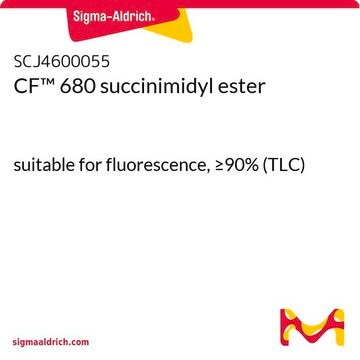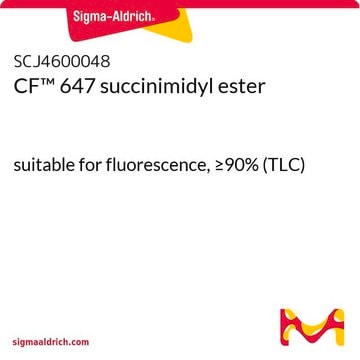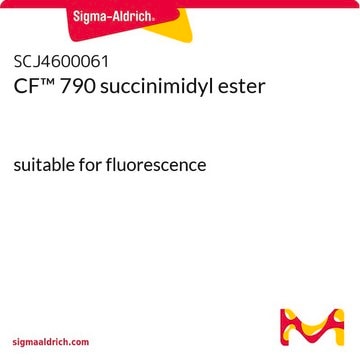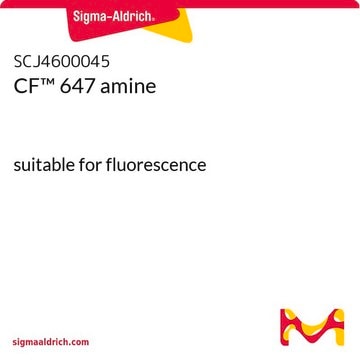General description
CF™ 750 succinimidyl ester (CF750 SE) is used for labeling proteins or other biomolecules having an amine group. The succinimidyl ester group of the dye reacts with an amine group to form a stable amide linkage.
Near-IR CF dyes are a group of fluorescent dyes with absorption and emission wavelengths between 650 and 800 nm. Near-IR CF dyes are significantly brighter and more stable than any other commercial dye of similar wavelengths. Near-IR CF dyes offer important advantages over traditional visible light dyes. Because cellular or tissue components produce minimal autofluorescence in the near-IR region, near-IR dyes have the potential to offer highly specific and sensitive detection in complex biological systems. Also, because light with wavelength in the near-IR region has strong tissue penetration, near-IR dyes are ideal for in vivo fluorescence imaging, an emerging field that has advanced rapidly in recent years. Futhermore, near-IR dyes are also excellent dyes for in- or on-cell and membrane-based Western assays. CF750 is so bright, it can be excited at 633 nm, but still emits stronger fluorescence at ~770 nm than APC-based tandem dyes, making the dye particularly useful for flow cytometry applications without the spillover and stability challenges encountered with tandem dyes.
Application
CF™ 750 succinimidyl ester is suitable for labelling antibodies during for xenograft Imaging of CD25-positive tumors. It may also be used for labelling proteins to track the protein delivery in nasal mucosa using nanoparticles containing an anionic lipid in their core (NPL).
Features and Benefits
1. Near-IR CF dyes are exceptionally bright and stable. 2. Water-soluble. 3. Ideal for in vivo image. 4. Less immunogenic than other competitive dyes.
Preparation Note
Protect from light and moisture
Reconstitution
Dissolve in DMSO
Legal Information
This product is distributed by Sigma-Aldrich Co. under the authorization of Biotium, Inc. This product is covered by one or more US patents and corresponding patent claims outside the US patents or pending applications owned or licensed by Biotium, Inc. including without limitation: 12/334,387; 12/607,915; 12/699,778; 12/850,578; 61/454,484. In consideration of the purchase price paid by the buyer, the buyer is hereby granted a limited, non-exclusive, non-transferable license to use only the purchased amount of the product solely for the buyer′s own internal research in a manner consistent with the accompanying product literature. Except as expressly granted herein, the sale of this product does not grant to or convey upon the buyer any license, expressly, by implication or estoppel, under any patent right or other intellectual property right of Biotium, Inc. Buyer shall not resell or transfer this product to any third party, or use the product for any commercial purposes, including without limitation, any diagnostic, therapeutic or prophylactic uses. This product is for research use only. Any other uses, including diagnostic uses, require a separate license from Biotium, Inc. For information on purchasing a license to use this product for purposes other than research, contact Biotium, Inc., 3159 Corporate Place, Hayward, CA 94545, Tel: (510) 265-1027. Fax: (510) 265-1352. Email: btinfo@biotium.com.
CF is a trademark of Biotium, Inc.
Disclaimer
Unless otherwise stated in our catalog or other company documentation accompanying the product(s), our products are intended for research use only and are not to be used for any other purpose, which includes but is not limited to, unauthorized commercial uses, in vitro diagnostic uses, ex vivo or in vivo therapeutic uses or any type of consumption or application to humans or animals.








